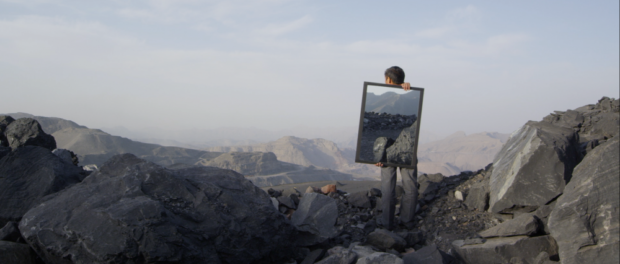Behemoth: A Poetic Journey into the Pit of the Earth
written by Zeina AlThawabteh
If you are a fan of art films and poignant documentaries, then this film is for you. Through a succession of captivating yet bleak visuals, Behemoth makes you feel the impact of the global environmental crisis in your bones.
Set in Inner-Mongolia, Behemoth follows the supply-chain of construction materials, starting with coal miners, iron-ore miners and ending with the ghost cities of China. The film is a stark commentary on the global environmental crisis and the role of man in creating and perpetuating it. The director artistically documents the destruction of lush pastoral landscapes into barren, soot-covered mountains. The human element takes centre stage and the viewer is constantly reminded of the daily struggles of the miners as they breathe in clouds of ash and endure the scorching heat of the iron mines.

Behemoth.
Structured after Dante’s Divine Comedy, the film is divided into three parts: inferno, purgatory, and paradise, which are represented by the mines, the state of miners who have developed respiratory diseases, and the ghost cities, respectively. During the two-year filmmaking process, the director referred to the mines as hell when discussing it with friends. Gradually, the idea of hell led him to draw on the epic poem’s themes. As such, the film starts with an explosion in one of the mines and ends with striking shots of one of the Chinese ghost towns.
Liang states that ‘while the film is set in China, [he uses] it as a motif to what is happening all around the world.’ Indeed, he successfully conveys that the impact is universal and explores the dehumanizing effect of incessant consumption. The documentary illuminates the dichotomous role of man as both the perpetrator and victim of environmental devastation and the viewer is made to question their part in this crisis.

Behemoth.
Behemoth deviates from the common documentary template in many ways. The director merges documentary filmmaking with art, where every still is a standalone artful composition. The film is also infused with symbolism and motifs. Some of these are the seemingly never-ending landscapes that represent the ubiquity of the devastation and the repetitive working motions by the miners representing their interminable struggle.
There are two recurring figures that add a metaphysical dimension: a naked man and a man carrying a mirror who is perhaps calling for some reflection. The director exclusively relies on a voiceover of excerpts from the Divine Comedy, eliminating the usual narration tools like dialogue and interviews. The stirring soundscape is comprised of a Mongolian chant, the emphysemic breathing of the workers as well as the ceaseless and deafening sounds of heavy machinery.
Variety magazine describes this documentary as ‘an impressively self-shot poetic exercise in controlled righteous outrage, emphasizing the contrasts between rapidly dwindling green pastures and dead landscapes disemboweled by toxic mining.’ The nonconforming director set out to assert the imminence of the environmental crisis, and that he did. No documentary on the environment comes close to capturing and conveying the gravity of the situation. You will finish the film feeling implicated and sick.
Behemoth screened at Cinema du Parc as part of RIDM+‘s monthly screening series.






